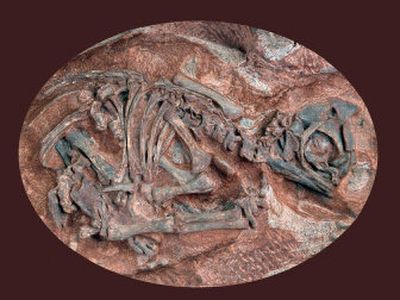Eggs give Jurassic clues

WASHINGTON – The discovery of the oldest dinosaur embryos ever found is enabling scientists to piece together the lifetime growth of a type of long-necked giant that lived 190 million years ago.
Years of study have turned up new and fascinating details of Massospondylus carinatus, a plant-eating dinosaur that lived in the early Jurassic age in what is now South Africa.
The discovery is producing three important results, Robert R. Reisz, of the University of Toronto at Mississauga, said Wednesday.
The first, he said, is the “Gee whiz, Guinness world record that we have found the oldest dinosaur embryo. That’s cool, and they are beautiful.”
The second is the hard science, said Reisz. Scientists are now able to look at the growth pattern of the animal from embryo to adult because they have skeletons from various states of its life and can compare changes as the animal grew.
The third area, he said, is most speculative. Some of the embryos were clearly ready to hatch, he said, but they have no teeth, “and that suggests to us that some form of parental care was required … not just protecting but active feeding.”
The report by Reisz and others at the University of Toronto, the Smithsonian Institution’s National Museum of Natural History and the University of the Witwatersrand, South Africa, is in today’s issue of the journal Science.
James Clark, a biology professor at George Washington University in Washington who was not part of the research group, concurred that these are the oldest dinosaur embryos yet found.
“The importance of the discovery is that they are from a primitive member of the sauropodomorphs, a large group that includes the biggest land animals that ever lived. Sauropodomorph embryos are rare, and the only previously known embryos of this group, from Argentina, are from a much later and more specialized form,” Clark said.
“Surprisingly,” Clark said, “the proportions of the limbs, neck and head suggest that as a baby and young animal this species walked on four legs, but as an adult it was able to walk on two legs some of the time. This kind of change in posture hasn’t been documented in any other dinosaur.”